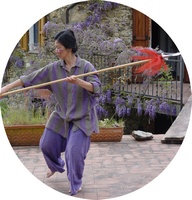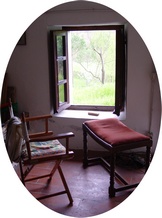
experimental online version with video
Help Cook ~ Taiji as a culinary art
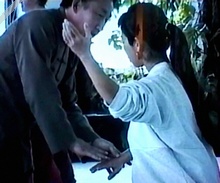
My practice was guided by a gradually awakening sensing of the body’s internal connections. Little by little, after the initial phase of being quite overwhelmed by the excellence of Chen XiaoWang’s TaijiQuan, I began to be able to see where the power was coming from. The ability to discern to some degree what is happening inside the teacher’s body, comes from sensing certain connections in one’s own body. These connections, when strengthened and brought under conscious control, underlie a completely different way of moving, aptly called ‘moving from centre’. Through exquisitely detailed guidance of the student’s movement, and precise indications of the alignments which need to change, the teacher can elicit in the student a rudimentary sense of these connections. The most direct and effective way for the teacher to communicate this is through his hands. Chen XiaoWang calls this way of teaching, ‘hands language’.

after this, don’t worry…
number four… qi to dantian
First comes ‘body language’; Master Chen shows us with his body a different way to move. Then there is the language of words; he explains to us how he is moving, and explains how we can try to do the same. Then there is ‘hands language’; through his guiding touch, feather light yet focused and insistent, he directs the student’s movement along courses which cannot easily be discovered.
Seminars with Master Chen involve long sessions of learning — watching, doing, watching again, trying again. During these periods, when we are being taught without words to refine our capacity to observe, he does not allow questions to be asked. Then, after we have taken in as much information as we can, he will say brightly, “Question time!”
Perhaps a student will step forward, with a query about a part of the form. Chen XiaoWang will have her do it as best she can, and if he is in the mood, he may himself show the section again. Or he may pause the student in mid move and say, “Correction!”. The group becomes alert, for we know that there is going to be a demonstration of ‘hands language’.
Many of his students have experienced this method of teaching, some despite themselves. They may have come up with some particular question, but found themselves being given an answer to another question, one which they did not know they had. The posture which they present moves Chen XiaoWang to respond to this most urgent of questions.
Being answered in this way, a few never step forward with a question again!
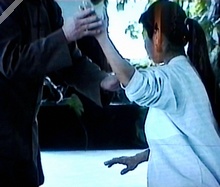
Listening
When one is intensely involved in trying to carry out a movement, one might not even hear what the teacher is saying, let alone feel the touch of his hands. Having the idea that a stance is challenging, that it is big and deep, we dive into the imagined deep end. The mind is fixed on an idea, the muscles are tensed in trying to carry out that idea. Awareness is often not present.
after… here change
The advantage some students may have is often due not to previous experience in taiji, but simply to being able to relax and not worry about how one appears. Previous experience is often a hindrance. Early in my training with him I was complimented by Master Chen who said, “Kinthissa very easy to correct.” The person sharing the lesson with me said, “Of course she is, she has been doing taiji for nineteen years!” To this, Master Chen replied, “But this very difficult to correct.”
I was not particularly laid back, and by nature I try hard at things I want to do. Yet from the start I was receptive to the language of his hands; they spoke to me clearly, and affected me deeply.

Depending on one’s sensitivity, his touch can be light, hardly there and yet clearly guiding. Often the message is straightforward — let go here in the shoulder, turn the left palm before shifting weight to the right, allow the head to follow the leaning spine. But even with such an apparently simple direction as, “relax this spot on the top of the left shoulder”, a direction given without a word being spoken — if one listens to its prompting, one might be fortunate enough to catch an unmistakable linking running all the way from left shoulder to opposite hand as one starts to shift weight to the right.
Led by his hands, I moved along an unknown path. There was no need of knowing, the way was clear, seen in a wordless light. The breathing became very subdued. I think this was the result of how keenly the body was listening. For those moments, I was charged from a source that lay within me, a source I would slowly come to appreciate.

But the way is long, and those moments that I experienced in my first year of training under Chen XiaoWang were glimpses of an unimaginable terrain within the body. To travel further in Qi-scape, I would need years of practice. Indeed I am a novice on the way trodden by masters such as Chen XiaoWang.
Having lived with the taiji for some years already by the time I came to this technique, I realized the value of those glimpses, and dedicated my resources to further understanding. Many who are new to taiji may find such experiences extraordinary, but as novel sensations, they disappear; what remains is the memory of a possibility. Master Chen says that the mind is more important than the body in taiji training. The greater part of what the student brings to the training is their mental capacity and keenness of discernment, their desire to learn, and ability to persevere.
Chen and the Art of Cooking
Chen XiaoWang sometimes draws an analogy between eating and learning: breakfast must be digested before you can eat lunch, likewise the morning’s seminar; no use being greedy and stuffing in too many forms too quickly, etc.
But another matter more interesting, and challenging to try to put into words, is the art — not of eating — but of cooking, in Chentaiji. In the next chapter, about the standing practice ZhanZhuang, we shall see the kinds of changes that occur while one is apparently motionless. Bringing about such changes, and recognizing what is happening both physically and energetically, is a skill that I have acquired through being ‘cooked’ by Master Chen.
We — Ben and I, and a few of our taiji friends — call it ‘cooking’, because of the intensity of the experience in these close encounters with a truer alignment, ‘correct’ structurally and energetically, and perhaps the latter beyond the confines of structure.
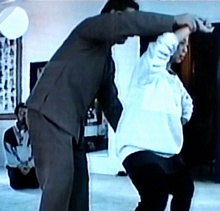
Fortuitously, one of my first experiences of this kind of intensity was captured in a rather fuzzy video during a lesson in Switzerland, in 1996; the pictures earlier in this chapter show the beginning of the sequence, the gentler part of the experience! They lead up to something rather different, as we shall see.
The stance, bei zhe kao ‘Lean with Back’, is one of the more demanding positions of Chen Style, occurring in both LaoJia and XinJia. The legs are wide with the feet level, the right foot a little turned out with this leg bearing the weight, and left leg stretched out to the side, foot placed straight. Both hands are fisted, the right arm twined out to its end position with the fist palm out above the head over the right shoulder; the left arm is folded in with the knuckles of the fisted hand pressed into the soft part of the waist on that side, palm facing down.
People really groove into this big Chen move more or less like this: first they take an enormous step out to the right, and throw themselves to that side; then they thrash about, left and right, and by the time they are in the final position, over the right leg, they have lost all points of reference. The finishing touch to the scene is a wrung neck atop a twisted torso.
I imagine I did it in a similar fashion. The stance is full of drama, and one sees Chen XiaoWang breathing like a dragon astride a storm cloud, or like a god emerging from some watery realm. We do not know, or we do not remember in such moments, that he has worked on this stance for half a century. When it appears to be such effortless skill, we forget that it has taken hours of practice daily for much of a lifetime. He acquired his cooking skills over decades and knows his own body so well that he can see into ours.
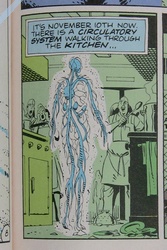
a circulatory system
walked through the kitchen
Ben once asked Master Chen what he sees when he looks at us. As Master Chen was mulling it over, Ben produced a picture book. It was a science fiction story where a man has been stripped down to a network of nerves, veins and arteries …… Master Chen laughingly said, yes, I see you a little bit like this!
A Chen XiaoWang correction happens more or less along these lines: he first tackles the hands and arms, making you less tense in them, the position less extreme than the tight spot you got yourself into. His touch is so sure, so light, that you trust him and begin to relax; you may even have the thought, that perhaps it’s not so difficult after all. This is Master Chen setting up the stage for beginning the real work. In order to commence the deeper adjustments, which are to pelvis and torso, the more relaxed and willing you are to go with it, the easier it is for him to carry out his masterly task.
Many people in seminars ask to be adjusted in the huge dramatic stances of Chentaiji. When it is someone who is not familiar with the technique, it can be a pointless undertaking. I know from feeling under my own hands the body of a person who is not ‘ripe’ yet for correction; there is very little substance to work with. After all, since there is a body, perhaps a strong one, standing there asking to be worked on, why is there a remarkable difference between a trained body and an untrained one, or one not yet trained enough, or not trained in this technique? How much does mind, the awareness, the understanding, play a part in the whole affair?

I remember from that first big correction — for that is
what it is, and we say ‘adjustment’ to be politically
correct — the immense effort involved in taking the
correction. First, we stand and take up a stance in a way
that is skewed to our particular misalignment. Then, when
parts of the frame begin to be moved towards a better
relationship with other parts, sensations may arise of such
ferocity that we easily label them as ‘pain’. One needs to
be able to take a back seat and observe what is happening,
rather than be freaked out immediately and jump out of the
stance. 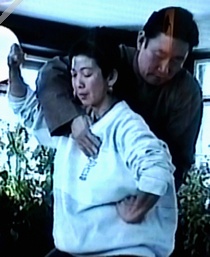 The
feeling in one way or another is of qi being nudged and
shifted, caused to flow in a hitherto unknown way. Tension
is qi, and flow is qi. One is tight and unyielding, bottled
up qi; the other is light and carefree qi.
The
feeling in one way or another is of qi being nudged and
shifted, caused to flow in a hitherto unknown way. Tension
is qi, and flow is qi. One is tight and unyielding, bottled
up qi; the other is light and carefree qi.
I think that it is not the correction which stresses us; the correction puts us face to face with the deep underlying holdings. The sensations can be indescribably intense, sometimes a burning in the upper thighs and a searing through the legs which takes away all their strength to remain useful, as limbs that support your weight. Many a big muscular man has collapsed under the impact of Master Chen’s ‘hands language’.
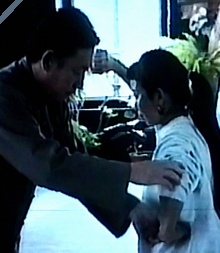
On this occasion he began slowly, making little changes to my fisted hands, already somehow affecting with these alterations the shoulders and chest. The adjustments during ZhanZhuang, the standing practice, are also like this. He takes, with his two hands, your hands which are up before your chest. His hands sense your reluctances; your hands inform him where you are holding back. With a few very slight movements he can set off a kind of flushing through your arms, which you feel all the way to your chest.
Then it was time
to tackle the core posture. After making a couple of further
small adjustments to my fisted hands at their respective
positions, he stood behind me and placed his hands, one on
each joint, where the femur comes into the hip socket. I
think it was with the four fingers of each hand that he was
sensing out, minutely, the orientation within the inguinal
fold. 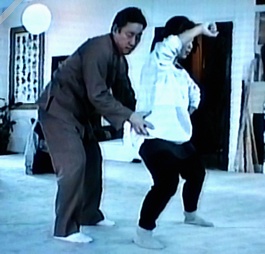 His
thumbs bracketed my hips, and between applications of
varying pressure between thumb and fingers on both sides of
my pelvis, he was altering the way my legs were sitting
within the hip joints. Then holding the alignments together,
he sat me down deeper into the now more correct posture.
His
thumbs bracketed my hips, and between applications of
varying pressure between thumb and fingers on both sides of
my pelvis, he was altering the way my legs were sitting
within the hip joints. Then holding the alignments together,
he sat me down deeper into the now more correct posture.
Next to be tackled
was the sacral spine. Still standing behind me, he put his
right arm over my right shoulder to place his hand on the
sternum; the palm of his left hand held the top of the
sacrum, the heel of the hand placed to exert pressure from
behind. 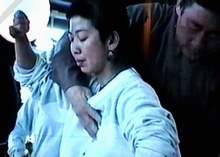 Now
it was prime time: the two hands probed and felt their way
inside the structure of my body. I cannot say that there was
pain, as there seemed to have been during the adjustments to
the hips. There was something like a storm raging within my
chest. My eyes were tightly closed, all my attention
entirely focused interiorly.
Now
it was prime time: the two hands probed and felt their way
inside the structure of my body. I cannot say that there was
pain, as there seemed to have been during the adjustments to
the hips. There was something like a storm raging within my
chest. My eyes were tightly closed, all my attention
entirely focused interiorly.
A whirlwind of
sensations is sweeping through me. Every now and then, there
is quiet, as if parts at odds with one another have joined
up, giving me relief. Then I am taken further, to another
juncture along the way to reconciliation. 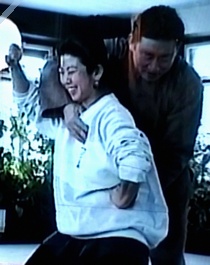 Master
Chen
is looking for that conjunction, that only he knows of. We
are drawing closer to it, but by now my body is protesting
strongly. Urgently he tells me not to move. I allow myself a
second’s reprieve, but I want to go through this experience;
I return to the task at hand.
Master
Chen
is looking for that conjunction, that only he knows of. We
are drawing closer to it, but by now my body is protesting
strongly. Urgently he tells me not to move. I allow myself a
second’s reprieve, but I want to go through this experience;
I return to the task at hand.
There were moments when I nearly said, “Please, enough,
Master Chen.” But no words were spoken. Then there came a
scene which I saw and felt at the same time. My body, its
outer frame, was standing, and falling inside its walls was
rubble and dust in a slow descent from all sides; in slow
motion an inner world was crumbling.  All
this
happened within me, I do not know what was visible on the
outside. It was utterly vivid, and completely still and
mute.
All
this
happened within me, I do not know what was visible on the
outside. It was utterly vivid, and completely still and
mute.
Watching the video now, I can see that there is a sudden giving way to rightness; I recognize the place, although I have never been there before.
Then Master Chen
returned to the hips, placing his hands like before at the
tops of the thighs. This time he clearly moved to shift my
weight more onto the right leg. Once or twice he had to
reach down in order to turn out my left thigh and knee,
which were starting to collapse inwards as the stretch from
foot to hip increased. 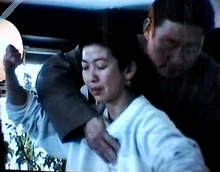 More
and
more weight was taken over to the right, and this was the
most obviously strenuous part of the undertaking; at this
point I nearly gave up.
More
and
more weight was taken over to the right, and this was the
most obviously strenuous part of the undertaking; at this
point I nearly gave up.
He came around to the front to cast his eyes over the situation. Not yet ready. Legs shaking and on fire, torso somewhere unknown, I remained in ‘Lean with Back’ while he returned to put the final touches (for this occasion) to the work.
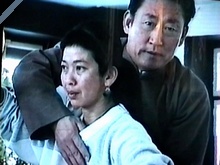
In the years since then, I have experienced this kind of correction many times. Every time, however prepared I may think I am when Master Chen approaches to alter my stance, the ensuing assault on my fixities takes me by surprise. It may fairly be described as shocking.
The correction often begins gently. Having worked some
years already towards improvement, I may even allow myself
to think, “Ah, this adjustment I could not have taken so
easily last year; now I am stronger!” 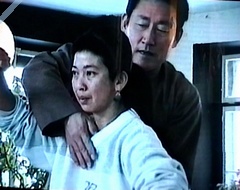 Even
while
I am having this thought, perhaps I unexpectedly relax
somewhere critical, for suddenly he is able to take me
further and deeper than ever before, or so it feels, from
the blast of heat that passes through me like a desert wind.
Inside those walls where an interior world crumbled in 1996,
there are piles of old leaves that catch fire; I watch the
conflagration, and feel thankful to clear one more dead
pile.
Even
while
I am having this thought, perhaps I unexpectedly relax
somewhere critical, for suddenly he is able to take me
further and deeper than ever before, or so it feels, from
the blast of heat that passes through me like a desert wind.
Inside those walls where an interior world crumbled in 1996,
there are piles of old leaves that catch fire; I watch the
conflagration, and feel thankful to clear one more dead
pile.
Here is something I wrote a while ago, about this experience of Chen XiaoWang corrections:
It may take him time to change your weight distribution:
the stance requires the weight committed to the right
side, the left leg stretched and dramatically twined all
the way through …  the
burning is unbearable in the right thigh, the left leg
shakes uncontrollably. You may panic as your entire body
is gripped by overwhelming sensations.
the
burning is unbearable in the right thigh, the left leg
shakes uncontrollably. You may panic as your entire body
is gripped by overwhelming sensations.
Then all of a sudden you stop resisting, you yield in your chest. Your mind clears … “If you can fill the unforgiving minute with sixty seconds’ worth of distance run” … you stay. The body is in tatters but you are calm. He returns to your hands. A tiny touch here and a tweak there at the periphery result in a flooding of qi throughout your torso. Zoom down into dantian … out to heraldic arms.
You are happier than you have ever felt. Chen XiaoWang steps back, satisfied. He announces, “This now TaijiQuan.”
… “Water boiling” …
Zhuangzi wrote of Cook Ding whose chopper remained as fresh as it had come off the grindstone although he had taken apart several thousand oxen. The cook explains his art, to “insert what has no thickness where there is an interval,” so that “at one stroke the tangle has been unravelled…. I stand chopper in hand, look proudly round…”. (A. C. Graham, Chuang-tzǔ: The Inner Chapters, George Allen & Unwin, London 1981 ~ chapter 3, ‘What matters in the nurture of life’, p. 64)
Help Cook
The phrase is one of Chen XiaoWang’s favourites. When he is a guest in somebody’s house and he sees that there is a small amount of food remaining in the pot at the end of the meal, he will gleefully serve out the food to anyone still able to eat it, announcing “Help Cook!” (meaning, “Help the Washer-Up!”).
At one of our bi-annual gatherings in the Bienne dojo, we announced to Master Chen that we were trying to learn to correct ourselves, instead of waiting until the next time we saw him. He said, “Yes, not wait!” So, how to Help Cook?
The experiences of being repeatedly adjusted in ZhanZhuang and Chansigong gave me a storehouse of internal references to work from on my own. Chapter 1 touched on learning to recognize the feeling of qi flowing. It is a process of exploration that starts with examining the lack of that feeling, after the teacher’s guiding hand leaves you.
When you begin regular standing practice on your own, say some twenty to thirty minutes daily, the guide to follow is the internal sensing. Outer details, such as where your arms were put by the teacher, are not really of much use. When he grasped your arms and put them in a particular position, it was in order to free you up, internally, as he found you on that day. Another day may well be different. Still, there are general guidelines which usually apply. For example, the enthusiastic apprentice will likely try holding her arms up too high at the beginning, before having learnt to relax the chest, and so the teacher will often lower them; in such a case, it is useful to be guided by memory. But beyond common sense details such as that, you want to look rather for the internal changes that the teacher brought about in you through external manipulation.
When I am receiving a correction from Chen XiaoWang, I tend to close my eyes. I notice that many people, when corrections are being made to their posture, often look down anxiously at the adjustments being made, hoping to remember the corrections from the appearance. I suggest, instead, close the eyes and listen with your whole body; try to feel and follow the internal shiftings. Each alteration that the teacher makes has an energetic effect; we want to experience this as fully as possible, to learn to distinguish, on a finer and finer level, the differing effects that outer changes can have. When one returns to practising on one’s own, these internal signs will be the guide for ‘self-cooking’.
Early on in the training, the changes that are made to the posture are usually big ones. The back may be so arched, the chest so lifted, that Master Chen has to move you around a lot in order to get you closer to something sensible. The aim of the student should be to Help Cook. At the next chance for a correction, if you can find for yourself some of the changes that were made, then the teacher can continue from where he left you last time. Slowly the adjustments become more and more fine, until they may be quite imperceptible to the onlooker, even though whole worlds of difference are being created inside the subject.
But the abundance of energy brought about by these changes, especially by the most imperceptible of adjustments, is there for all to see. A person is transformed. Every one becomes beautiful, full of an inner dignity. This is the meaning of de, virtue, the realization of potential. The power obtained from being in accord with the dao.
Self-cooking
In early days, whenever I asked Ben how his practice had been that day, he would say, “Like the small drumbeat of raindrops on a mountain.” Water wears away the hardest rock. In time. It helps us to build technique when we take a long view of the process. Perhaps we should regard our bodies with a perspective similar to that of the potter, who works with materials that have passed through the ages.
Knowing the secret ways of the winds and the rains, he penetrated deep among the slumbering rocks and learned their histories. He became intimate with cosmic affairs and was able to assist the divine process of decay and rebirth. He took the rocks and pounded them; using subtle mixtures, he formed the vessels and works of beauty from loaves of plastic clay. With precision he learned to blow upon the flames and transmuted his fragments of hillside into fragile bowls for the delight and use of man.
- A.D. Brankston, Early Ming Wares of Chingtechen (Vetch and Lee, Hong Kong, 1970), p.61
With precision. An important skill which the taiji practitioner develops is the ability to tell the difference between good and bad pain. Bad pain is shrill and insistent, it makes you a more pinched person. Good pain increases your sense of substance, it leaves you feeling more grounded and balanced. Maybe the word ‘pain’ is not quite right for the second context. I will comment more on this later.
A danger in working on your own is that you may correct yourself too forcefully. You may easily fan the flames too enthusiastically and cook yourself to a crisp. So how to blow on the fire with precision, on one’s own?
Suppose that you have had the experience of being adjusted in a particular stance by the teacher. Then, later on, you try to find that place again by yourself. You remember the strenuousness of it, the way the thighs burned and your insides screamed. Well, it would be a bad idea to go about trying to recreate that experience! A correct position, or to express it more correctly, a better positioning than the one you begin from, needs the delicate alignment of many parts. This you cannot find, by yourself, in a forceful manner.
The correction given by the teacher might have felt forceful, but what he was doing, the amount of effort that had to be exerted on you, was most probably due to your resistance, the resistance of your body set in its habitual manner. Resistance also from your mind, afraid of pain, afraid of failure. The situation is inherently confrontational in some ways; it is all too easy to take the correction as a bout with the teacher, an endurance test before a public. In the limited time that is available, the teacher may need to cut a quick and direct path towards the goal of improved stance. Part of the difficulty for both participants is this factor of time; it is a charged set-up. Alone, one has the time to sense the way. The deepest changes need to be made step by step, zigzagging towards the goal. And when there is time, the teacher also may work like this, circuitously. Sometimes in ZhanZhuang, he may place your arms asymmetrically, in order to allow one side of the body to clear itself before it can join up with the other. A skilled teacher such as Chen XiaoWang may, if there is time, give you many months of roundabout adjustments before homing in on the ‘central problem’.
Watching Master Chen at work on his students, it becomes apparent that it is very hard for others to judge the effectiveness of the corrections being made. We can see only to a certain degree what is happening, what it means to the person being adjusted. Sometimes I have wondered why he has not changed the posture in a way that one would expect. It may be because it is not the time for that particular alteration. It may also be because he sees what we are unable to see, that the person is ‘working inside’. The student is aware and is making shifts towards wholeness, on such a fine level that it is invisible to almost all eyes.
Ben once proposed to me the idea that perhaps we appear to Master Chen like a plate of spaghetti (a plate each). The body may be a tangled mass of pathways, very few of them travelling along an open route. The teacher must begin by pulling out a strand here and a strand there; sorting out a few unravels others, and eventually, there is some sense. The ‘central problem’ may not be apparent to begin with; a jungle may have grown around it.
It is a long time before one can understand one’s predicament and how to go about changing it. It may be that one can change only to a certain extent, especially where problems arise from an old injury, and it may be more realistic to hope to gain an understanding of how other parts of the body can be recruited to help work around areas of weakness. Whatever the scenario, during the time that one is acquiring understanding and skill, it is the teacher who can take one to that charged place of confrontation with one’s difficulties. Progress can be set back by the attempt to recreate this intensity when practising alone.
In solitary practice, the best way to approach self-cooking may be as follows.
Go through the form continuously, noting the places where it feels uncomfortable. Do not pause, let the wave continue to the end of the form, or at least a whole section of the form. Preferably go through like this at least three times. Then, choose a stance and stay in it. Now comes the time to be delicate: sense your whole body, sweep your attention all the way through. At first, do nothing, make no change. Feel how you are, in the position you find yourself. See whether you are tense, anxious. Are you feeling cross with yourself? You know that when you are cross with someone, that person is unlikely to be receptive towards you. It is the same with your body. See if you can accept how you are in this taiji position, which you think is not very good. Your posture in actuality is almost certainly even worse than it feels! So be it.
Now, begin an experiment: relax, breathe deeply. However ineptly placed you are, this letting go of the mind’s grip on the body will initiate a good process.
With a relaxed attitude, you can now begin a slow simmering.
|
next |
